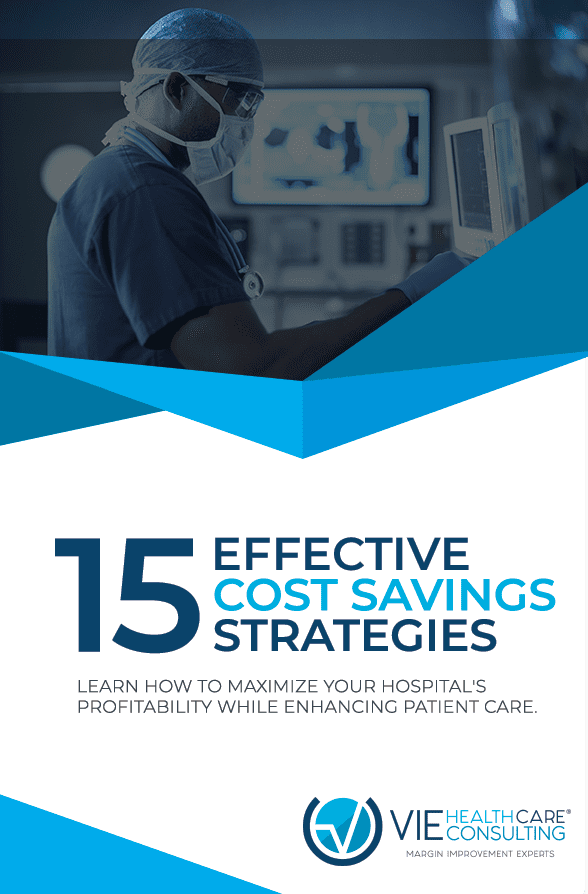What is Non-Clinical Burnout
This article was written by Rich Dormer.
As I was reading the featured Healthcare Executive article (Jan/Feb 2019 edition) by Maggie Van Dyke on ‘Battling Clinician Burnout’ it occurred to me that the points she made should be extended to battling non-clinical burnout throughout healthcare organizations.
I recognize that the focus of the article should rightly be on clinicians because they are on the front lines of patient care. But without IT, supply chain, support services and finance teams working so hard in the background, clinicians would not be able to deliver their outstanding performance day in and day out.
Non-clinical burnout is real
I have been working with VIE Healthcare Consulting since 2007. On a daily basis, we collaborate with leaders in both clinical and non-clinical areas to identify and achieve margin improvements for their organizations. These achievements allow for strategic investments and improvements to strengthen the delivery of patient care.
Over the years, I have witnessed first-hand how both the speed and volume of work our clients deal with have increased exponentially. And while new technologies have been advanced to assist them (remember – a smartphone 12 years ago was one that would actually work while you were in a hospital!) so have the costs and the growing demands on the back-end teams. These are vital to a hospital’s success.
My guess is that many of the non-clinical strategic leaders are working 60 hours a week just to keep up with their responsibilities.

Most of these leaders run from meeting to meeting every day with minimal breaks to maybe eat some food, fill up their travel mug with coffee, and reply to the most urgent emails in their inbox.
Phone meetings while in the car are a given to keep them connected with their teams or a key vendor partner and keep ahead of their ever-growing ‘to do’ list. A quick text message during a meeting to confirm the status of an important call that is happening at the same time is becoming the norm.
I am constantly amazed at the velocity of the work that is accomplished by these valuable resources.
What can be done to reduce non-clinical burnout?
Van Dyke is absolutely correct when she writes “burnout is largely a systems issue caused by environmental and cultural stressors” and I would add that these leaders have equally strong demands made on them in their personal lives.
What can be done?
#1 Addressing the administrative burden
Van Dyke writes that we need to address the administrative burden, but I would add to that and say we need to specifically address the bureaucracy of healthcare organizations.
To address non-clinical burnout we need to focus on the bureaucracy of healthcare organizations. Click To Tweet
In my view, one of the biggest areas that executives need to ask questions around is this:
How do we streamline our processes and what is holding us back?
“Bureaucracy by its nature resists change and nullifies progress,” James Cook.
A case study on bureaucracy
The following is a recent client example demonstrating the absurd ability of bureaucracy to negatively impact an organization.
VIE Healthcare identified and negotiated a ~15% reduction on an existing implant vendor for a Fortune 100 client within 20 days. At the time of writing, we are now on day 165 since it was sent to legal and has not been executed.
Note that there were no unreasonable demands or terms in the agreement and it included a 30-day without cause termination language – where is the risk? It’s caught in the bureaucracy.
We joked recently that we should start discussions on contract renewal but it’s a disappointing, yet real, example of how an organization can’t get out of its own way.
#2 Building better teams
Van Dyke is absolutely spot-on when she discusses building better teams and training front-line managers to be transformational leaders. Taking this one step further for the non-clinical team, organizations need to incorporate coaching and mentorship programs.

To develop exceptional teams with transformational mindsets is great but training alone will not get them there. For instance, who are Mike Mancias and Alex Guerrero? Answer: They are the trainers for two of the best athletes of all time – LeBron James and Tom Brady.
While you most likely have not heard of Mike or Alex, many of you will have heard of Butch Harmon, the swing coach of the #1 world golfer, Dustin Johnson. He was also the swing coach for Tiger Woods when he was the world #1.
Just like top sportsmen and women, the most successful businesses and their leaders utilize coaching and mentorship programs to help them and their teams to continuously improve upon their processes and drive the best outcomes.
Why should healthcare be so different?
In fact, one could argue coaching and mentorship programs are critical for healthcare leaders and their organizations.
The healthcare industry needs to think differently because the status quo has not made a dent on extracting unnecessary costs in our delivery system.
While the focus on clinical burnout is very important, I would argue that the focus on non-clinical burnout is equally important. Non-clinical teams provide the vital support to ensure clinicians have what they need, at the time they need it.
And the best way to avoid the non-clinical burnout is through coaching and mentorship programs and breaking down the bureaucracy walls.
The best way to avoid non-clinical burnout is through coaching and mentorship programs. Click To Tweet
Since 1999, VIE Healthcare has worked on the front lines, coaching and mentoring clinical and non-clinical leaders. Schedule a call with us today to find out how we can coach and mentor your teams to achieve their best performance.
For a complimentary consultation, call our office today at 1-888-484-3332, Ext 500 or email us at info@viehealthcare.com.



